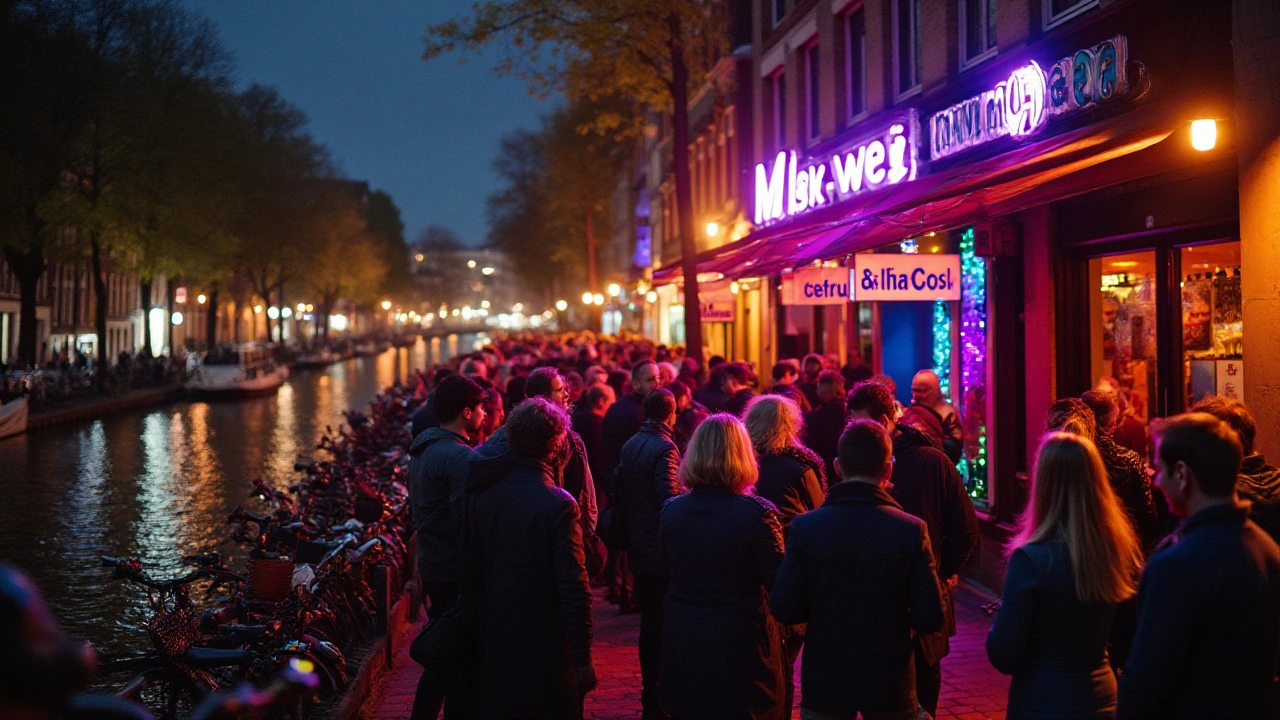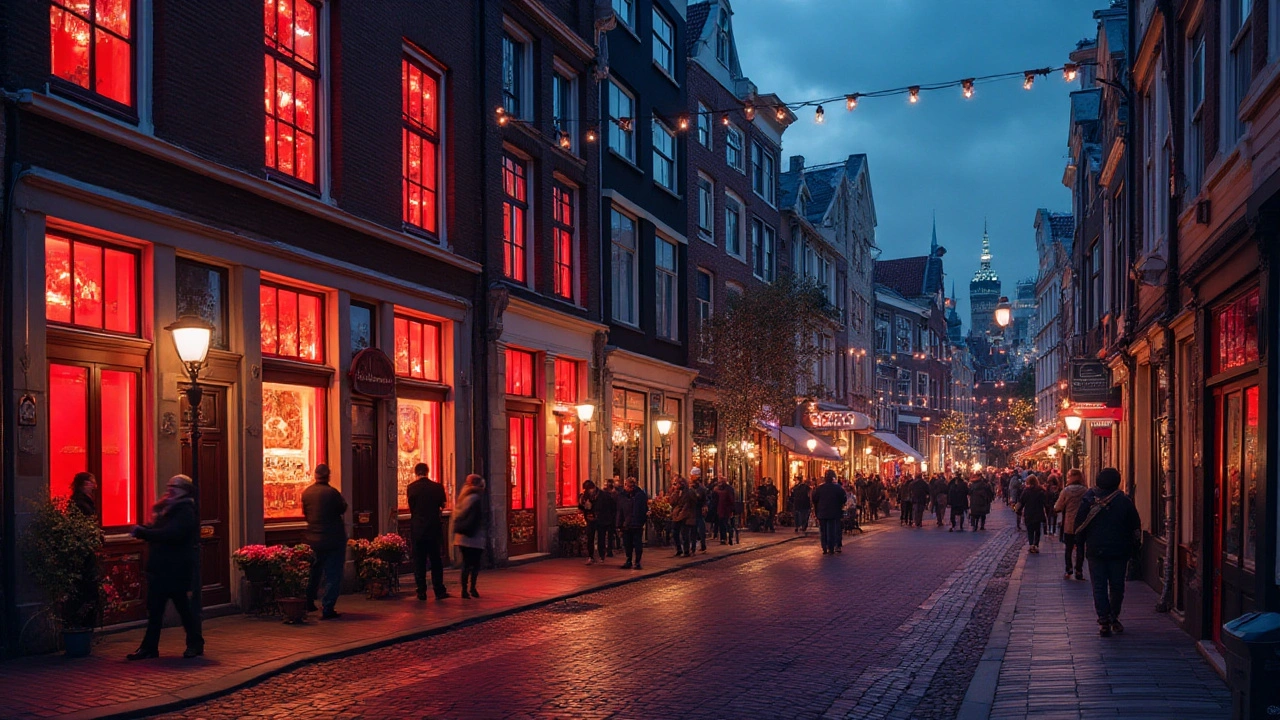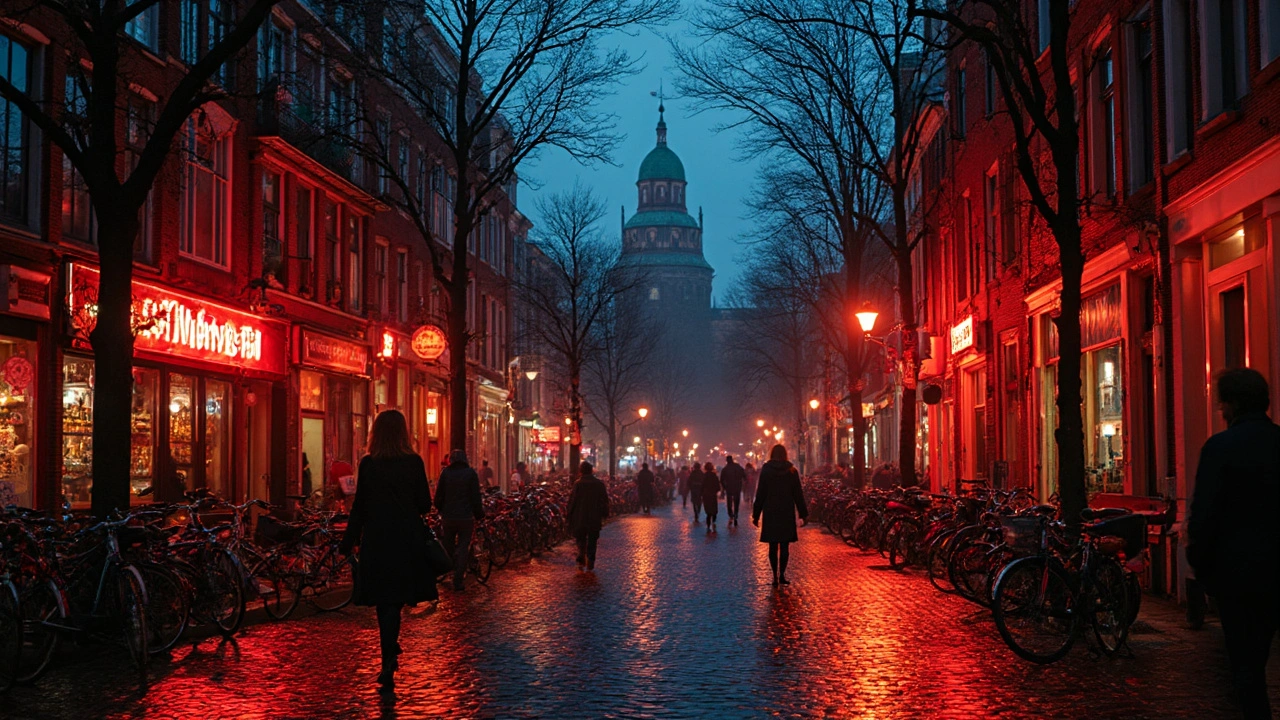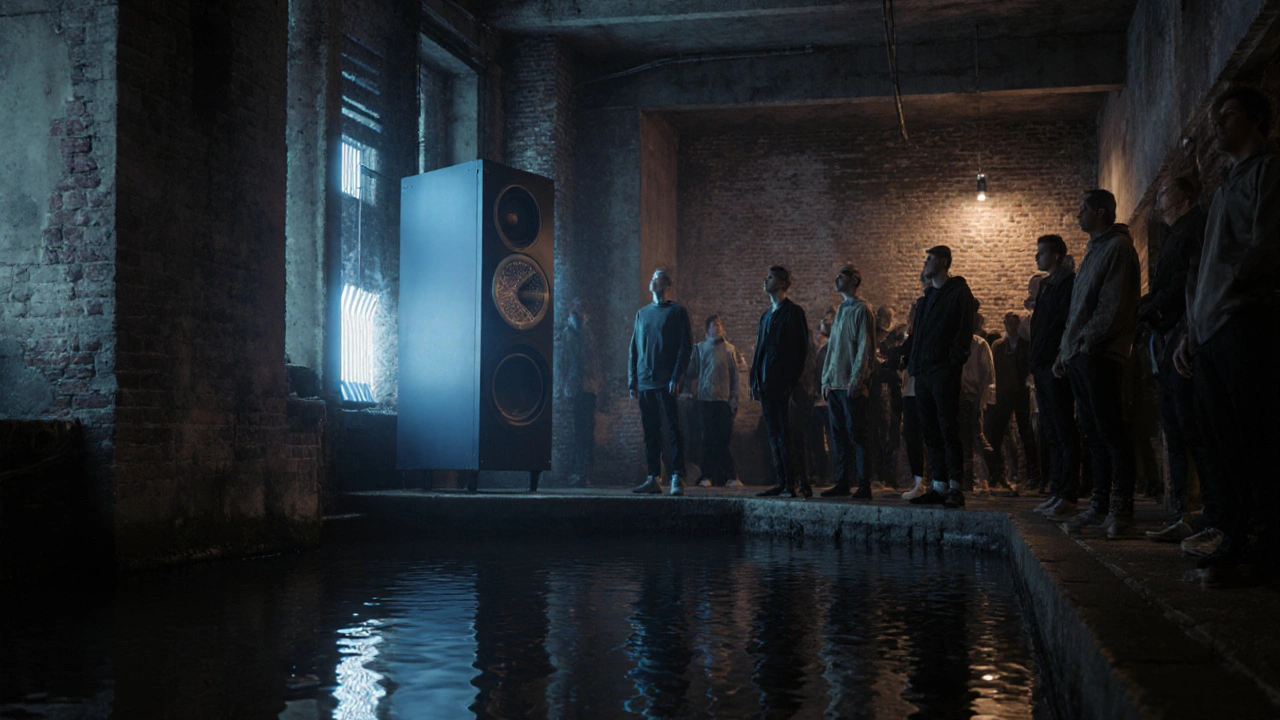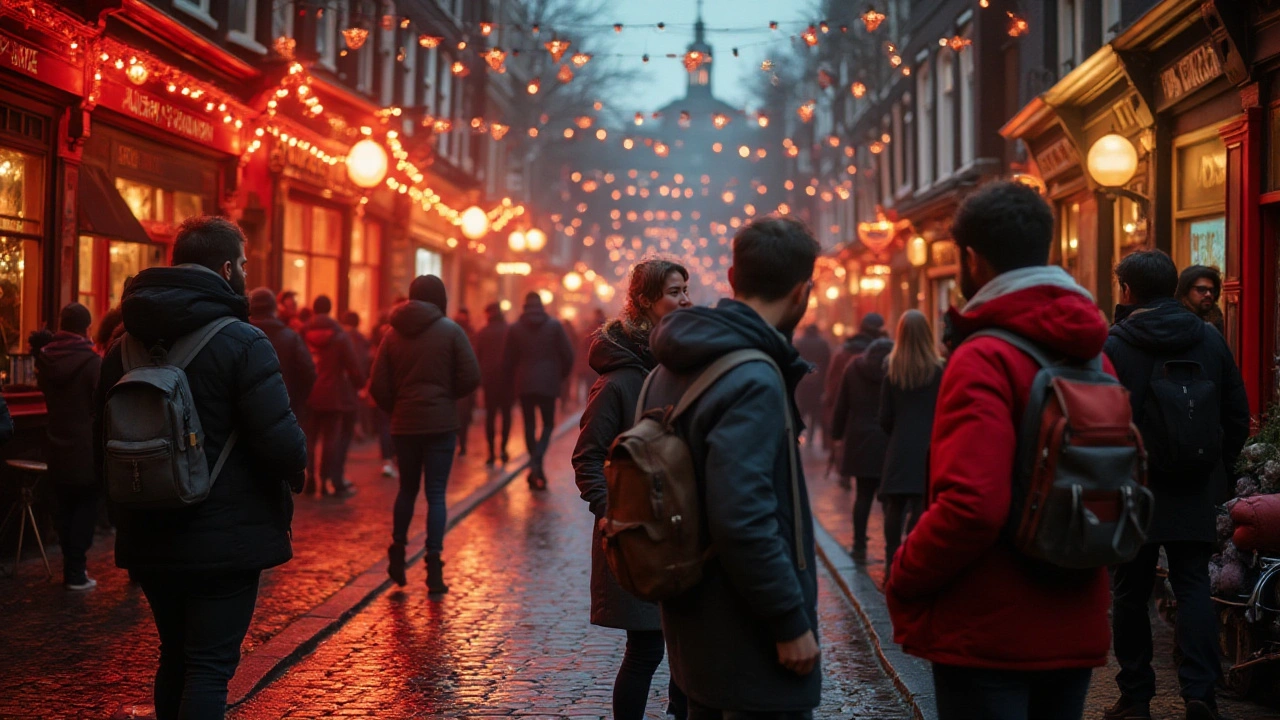
In the heart of the Netherlands, Amsterdam pulsates with an energy unlike any other city. Its famed Red Light District, known locally as De Wallen, captures the imaginations of travelers worldwide. But does reality live up to the myths spun by eager tourists? Join us as we peel back the layers of this vibrant neighborhood, where the whispers of history intertwine with contemporary tales.
Walking through its narrow alleys, one can't help but notice the combination of intrigue and tension that hangs in the air like a dense fog. Cafés linger beside canal edges, casting shimmering reflections of lights that twinkle and beguile those who wander. Yet beyond the allure lies a tapestry woven from Amsterdam's rich cultural history and progressive values, a confluence of past and present that lends each street corner its own unique narrative.
Through this article, we aim to offer readers a balanced perspective, grounded not only in sensory experience and local color but also practical insights. Whether it's absorbing the warm glow of lamplit windows or navigating bustling thoroughfares, an understanding of the Red Light District promises to enhance your journey through this captivating city. So step into the story, and allow yourself to get lost in one of the world's most enigmatic urban landscapes.
- History and Cultural Context
- Geographical Features
- Tourist Reviews: Perception vs. Reality
- Sensory Experiences in the District
- Practical Tips for Navigating the Area
- Balancing Tradition with Modernity
History and Cultural Context
Amsterdam’s Red Light District stands as both a symbol and an enigma, beckoning travelers from across the globe to uncover its secrets. To fully appreciate this iconic area, one must delve into its rich tapestry of history and cultural influences. The district, locally known as De Wallen, lies in the oldest part of Amsterdam, a city that rose to prominence during the Dutch Golden Age of the 17th century. During this period, Amsterdam became a bustling port city, drawing sailors from distant lands. These seafarers, yearning for respite and companionship after arduous voyages, found solace in the district's numerous alehouses and brothels.
With Amsterdam’s embrace of free trade and expansive maritime ventures, the Red Light District naturally evolved into a hub of indulgence and reprieve. A robust network of canals, designed to facilitate the trade of goods, also facilitated the flow of ideas and cultures, which in turn influenced the socio-cultural dynamics of the area. During these early years, prostitution was unofficially tolerated, laying the groundwork for the pragmatic Dutch approach to regulation—one that seeks harm reduction over prohibition, a philosophy that persists to this day. The labyrinthine streets, with their age-worn cobblestones, whisper tales of bygone eras where freedom and vice danced erotically in the red-hued glow of lamplight.
"The acceptance of such a neighborhood is largely due to the Dutch ethos of tolerance. Rather than repress desires, the city has historically sought to manage them, a respected cultural historian once opined."
As we turn to contemporary times, De Wallen remains a microcosm of Amsterdam’s liberal identity. It stands as a testament to the city’s long-standing infidelity to ordering lives by a moral compass dictated by others. The Dutch believe that personal freedoms, such as those exercised in the Red Light District, are essential to the tapestry of a pluralistic society. This ethos is woven into every corner of De Wallen, where traditional and modern elements coexist. The art of seduction flows through the district’s alleys like water through Amsterdam's iconic canals. Neon lights pulsate, inviting those who wander to view this aptly named 'city of sin' through an unapologetically sensual lens.
Influence of Economic Factors
An integral component of the Red Light District’s historical narrative is its economic impact. Amsterdam’s rise as a major European port established the district as not merely a social haven but a vital economic engine. Brothels, intertwined with local businesses and maritime commerce, thrived upon the influx of sailors and merchants. Today, tourism contributes substantially to its economic vitality, with an estimated several million visitors journeying specifically to experience its allure each year. The Amsterdam Tourism and Convention Bureau reports that this influx generates significant revenue, underscoring the district’s enduring importance to the city’s economy.
Thus, the Red Light District does not exist in a vacuum. It stands at the intersection of history, economy, and culture, a labyrinthine repository of the hopes, desires, and transgressions that define the human experience. Through a lens both scientific and sensual, one finds in its embrace a narrative that speaks as much to the human condition as it does to legal pragmatism and societal evolution.
Geographical Features
Nestled amidst the intricate labyrinth of Amsterdam's canals, the Amsterdam Red Light District weaves a tale of geographical charm that captivates every visitor. Renowned for its mesmerizing canal network, this area is a quintessential representation of the city's unique and bold architectural legacies. Here, the labyrinthine alleys and cobblestone paths guide your footsteps with a deliberate maze-like charisma, each turn revealing new layers of enchantment and historical intrigue. One is naturally guided by curiosity through streets lined with historic houses that tower gracefully alongside the meandering waterways, offering a visual tapestry reminiscent of a Van Gogh painting.
The interplay of land and water defines Amsterdam as few cities in the world. The canals—often referred to as the city's veins—breathe life into the district, bringing a rhythmic pulse evident in both day and night. As light dances off the gentle ripples, the canals echo tales of seafarers and traders who once breathed these waters centuries past. It's here that the sensory landscape transforms dramatically; the subtle blend of fresh canal air intermingled with hints of fragrant street foods adds a distinct sensual layer unique to the district. The intimacy of such an experience is akin to tracing the delicate lines of a centuries-old manuscript with your fingertips.
As one delves deeper into what distinguishes this urban enclave, a robust understanding emerges of how geography and human ingenuity have melded over the ages. Amsterdam's famed tolerance is mirrored in the openness of its spaces. The bridges arch gracefully over waterways, serving not only as routes but as vantage points from which observers can absorb the district's vibrant essence. In the words of noted cultural historian Johan Huizinga,
"Amsterdam stands as a testament to the enduring marriage between human spirit and the watery elements that bind us all."As evening envelops the district, a symphony of reflected lights plays across the canals, transforming the cityscape into a brilliant tableau vivant that holds its viewers in a gentle, seductive spell.
Exploring this district's geographical allure is akin to partaking in a dance—each step invites an intimate understanding of the harmony between city planning and raw natural beauty. The presence of old church towers peeking between rows of buildings hints at the district's storied past, marking historical moments when religious edifices shared streets with bustling taverns. This harmonious coexistence speaks volumes about Amsterdam's grace in fostering diversity within its compact yet expansive bounds. To those who venture, the Red Light District offers a sensory feast, its geographical features serving as the silent narrators of decades of passion, commerce, and culture intertwining seamlessly.
Iconic Canals and Bridges
Unique to the district are its canals, which serve not only as iconic imagery but as essential arteries in the city's ecosystem. Of particular note is the Oudezijds Voorburgwal, one of the oldest canals, where picturesque views combine with water that magnifies contemporary reflections like echoes from the past. Adjacent to these waterways are the ornate bridges that link neighborhoods, reminiscent of networks of capillaries feeding into the urban heart. The hustle and bustle seen on these bridges bear testimony to the enduring vibrancy and warmth Amsterdam graciously extends to those who wander its paths, infusing each moment with the vibratory hum of life.

Tourist Reviews: Perception vs. Reality
Amidst Amsterdam's canals and gabled houses, the Amsterdam Red Light District stands as a beacon of curiosity and fascination. It's a place where perception often dances a shadowy tango with reality, leaving many tourists mystified. On popular review platforms, visitors spill their surprises and awe, painting the area with broad strokes of exoticism and hedonism. Some embark with starry-eyed expectations, envisioning a place of untamed decadence. Yet, reality tends to be far more nuanced, rooted deeply in the vibrant cultural mosaic of Amsterdam. As one explores the cobblestone streets, the fusion of historic charm and modern vice prompts a reevaluation of preconceived notions.
What is often missed in tourist accounts is the district's complex history and the unique social progress it represents. Many reviews emphasize the visual spectacle – the soft glow of red lights reflected on slick cobblestones, semitransparent curtains revealing silhouetted figures, and curious glances exchanged with passersby. However, the heart of the district beats with a rhythm shaped by Amsterdam's open-minded approach to sex work, an example of the city's historically progressive values. Here lies a locality where legality and livelihood intertwine, providing insight into the Netherland’s pragmatic social policies regarding sex work as a profession – aspects that occasionally escape casual visitors, tangled as they are in clichés and abrupt judgments.
"The Red Light District defies its reputation as a mere tourist attraction," writes sociologist Petra Hiemstra in her acclaimed study on urban sociology. "Rather, it's a living tapestry – an embodiment of Amsterdam’s cultural and social heritage, where modernity and tradition coexist in a delicate ballet."
Beyond the allure of spectacle, there's another layer of reality: the community that gives the district its living spirit. Evening promenades through the district unveil an intriguing social structure where sex workers are not merely objects of curiosity but professionals with agency and voice. Tourists often express astonishment at the professionalism and security measures that govern these lively streets. It's a stark contradiction to the seedy underworld portrayed in folklore. Licensed workers pad their autonomy with a wealth of resources, access to medical care, and the benefit of operating within structured guidelines respected by local law enforcement. Such revelations often provoke a shift in tourist perception, viewing the area not as a den of indiscretion but as a microcosm of Amsterdam’s progressive ethos.
Innumerable narratives, however, fail to capture the district's vibrant auditory landscape. The distant ringing of bicycle bells blends seamlessly with the murmured cadence of diverse languages and the soft strains of jazz drifting out of tucked-away cafés. The result is an eclectic mix of sound characteristic of the district's spirited yet harmonious chaos. Couples hold hands, their fingers interwoven like strands of languorous melody, while friends laugh under the watchful gaze of crimson-lit windows. The sensory symphony compels visitors to reconsider simplistic reviews, unveiling the district as a multifaceted gem within Amsterdam's crown. Such intimate impressions elude the grasp of fleeting tourist reviews, offering a deeper, enriching reality.
Sensory Experiences in the District
As you step into Amsterdam's Red Light District, you're met with an undeniable symphony of sounds, scents, and sights—a vibrant cacophony that reveals the soul of this storied neighborhood. The air carries a tantalizing mix of aromas: freshly brewed coffee mingling with the earthy spice of cannabis from nearby 'coffeeshops'. The soft murmur of conversations drifts from quaint cafes, where patrons sip on rich, dark espressos while overlooking the maze of canals that crisscross this part of the city. The cobblestones beneath your feet are cool to the touch, remnants of an old world, while modern neon lights contrast sharply against the façade of historic buildings.
Your stroll is accompanied by the delicate notes of a distant accordion, a street performer adding musical texture to your walk. Each alleyway acts as a corridor to a new adventure, revealing corners filled with artful graffiti that speak to Amsterdam's fiercely creative spirit. As you wander, you're drawn to the glow emanating from the famous windows. Here, the district's allure reaches its zenith—a sensuous dance of intimacy and commerce, performed nightly in this enclave of open-mindedness. "The Red Light District offers a unique insight into human desire," notes cultural historian Dr. Iris van Cleef.
"It’s a testament to the city's embracing of individual freedoms while navigating the complexities of cultural and historical identities."
The tactile experience is equally vivid. The red-hued reflections on the canal waters ripple like molten glass, while the chill of the night air kisses your skin, reminding you of your journey into the heart of the city. It's an area brimming with juxtapositions: the austerity of a centuries-old church standing amidst modern pleasures, where history and hedonism coexist in surprising harmony. This is perhaps best encapsulated by the Oude Kerk, a magnificent gothic structure that stands stately amidst bustling nightlife—an anchor of history within the ever-evolving dynamics of Amsterdam. Its walls whisper stories of old Amsterdam, tales of sailors and merchant trade—an era when the city was center to the world's stage.
Texturally, you touch brass doorknobs and iron railings, weathered by time and each a keeper of stories untold. From time to time, the faint scent of tulips—iconic to Holland—might catch your senses, a reminder of the beauty that lives just beyond the city's contemporary allure. As you pause by a canal, the gentle lapping of water provides a soothing rhythm, lulling you into understanding that beneath its lively facade, the Red Light District is very much alive with an undercurrent of tranquility and deep-rooted tradition.
Whatever your reason for visiting—curiosity, exploration, or cultural study—the Red Light District promises an immersive experience unmatched by any other place. Here, the threads of Amsterdam's past and present weave a tapestry rich in color and texture, inviting each visitor to explore and contribute to its ever-evolving story. The district, in all its unapologetic candor, pulsates with life, inviting you to partake in a sensory journey that is as much about introspection as it is about external observation.
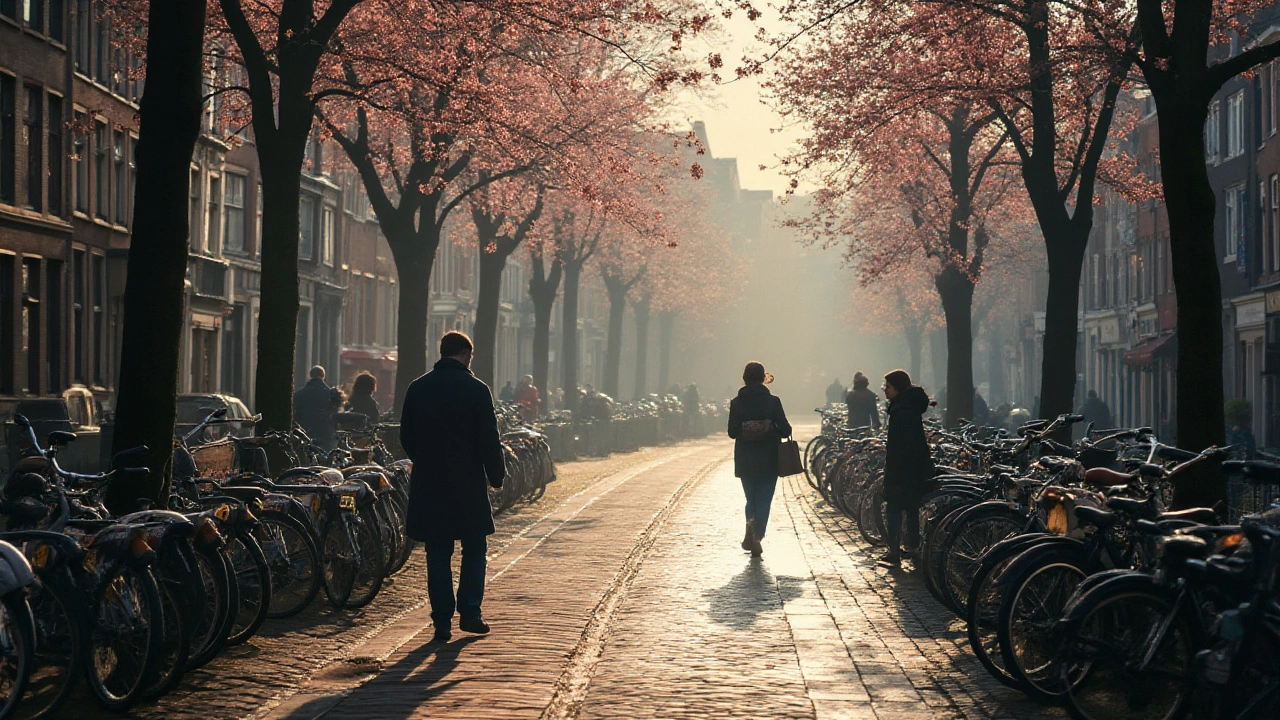
Practical Tips for Navigating the Area
Amidst the thrumming heartbeat of Amsterdam, where the air laden with the tantalizing scent of sweet pastries mingles unexpectedly with the hint of mischief, the Red Light District presents travelers with unique challenges and delights. Few places in the world encapsulate such a bold juxtaposition of the historical and contemporary, which makes navigating its labyrinthine alleyways a captivating endeavor. To ensure a rewarding experience while you explore this renowned area, it's crucial to equip yourself with knowledge born of both practicality and cultural awareness.
Firstly, pay mind to the district's sensory tapestry. As you wander, your senses will be bathed in a symphony of sights, sounds, and smells. Picture yourself under the glow of red-tinted windows as the whispers of centuries-old buildings share the echoes of lost stories. If you let the sound of live violin music spill from a nearby pub or the tangible distance of Rembandtplein guide you, you'll understand that Amsterdam's allure lies as much in its unpredictability as in its heritage.
Traversing these cobblestoned streets requires a sensitivity to both cultural norms and cues. Respect is paramount; while the district celebrates openness, acknowledge that window workers are professionals deserving of the same courtesy as any Parisian artist or Tokyo cafe owner. Capturing the vibrancy on camera might be tempting, yet snapping photos without permission breaches this mutual respect. Remain aware, maintain decorum, and foster an atmosphere of politeness around you.
"This district is not just a place; it is an embodiment of Amsterdam's spirit, where boundaries of tradition and modernity gracefully overlap," muses cultural historian Dr. Anita Vos, echoing the sentiments of many cultural enthusiasts.
To manage your journey with ease, consider an itinerary flexible enough to allow serendipity's charm to play its part. Engage with local events or festivals such as the prideful Canal Parade or King's Day celebrations, arresting moments where the district's prowess as a venue for inclusion cannot be overstated. Each embraces a spectrum of experiences, and the Red Light often steps eloquently into the limelight during such events, drawing visitors into an irresistible dance of color and sound.
For those who take comfort in details and statistics, a visit offers an opportunity for analytical exploration. Perhaps, create a list of sites infused with culture, like the iconic Oude Kerk, the earliest church in Amsterdam, which stands defiantly at the area's heart. For those curious about the darker tales, a visit to the Red Light Secrets Museum provides eerie insights entwined with fascination for history lovers.
Finally, as with any enthralling escapade, your tour demands intention. Choose comfortable shoes to tread the uneven terrain of history's remaining cobblestone, and plan breaks at cafes overlooking canals to observe Amsterdam's changing hues. What sets this journey apart is the intimacy interwoven with exploration, leaving lingering impressions stronger than any postcard photograph. By immersing yourself in both guideline and gustatory adventure with an open heart, the Red Light District shall divulge its charisma on your own terms.
Balancing Tradition with Modernity
Amidst the intricately cobbled streets and historic canals of Amsterdam, the Red Light District stands as a resonant testament to the city's ability to bridge the old and the new. Here, tradition and modernity coalesce in a delicate dance, with each twist and turn of the alleyways offering a masterclass in historical preservation and contemporary adaptation. As you wander through this iconic locale, whispers of the past echo alongside vibrant beats of the present, painting a picture simultaneously steeped in heritage and electric with change.
The architectural grandeur of Amsterdam's Red Light District is an homage to its rich history, with buildings that have withstood the test of time, forming a backdrop as seductive as it is instructive. These storied edifices reveal layers of history etched into their very foundations, layers that now mesh seamlessly with the modern ethos of inclusivity and progressiveness that the area exudes. It's a testament to how traditional structures not only house but nurture the pulsating modern culture within. Stumbling upon a corner café, one might find themselves enveloped by the aroma of robust brews while serenaded by the lively hum of diverse conversations—a sensory confluence epitomizing the spirit of tradition meeting modernity.
Yet beyond the facade, there's an art to maintaining this vibrant equilibrium. The district's ethos reflects Amsterdam's broader cultural philosophy—a dedication to tolerance and innovation, coupled with a grounded respect for its historical roots. As local authorities and businesses work to maintain this harmony, they aim to preserve the district's uniqueness without succumbing to the homogenizing forces of globalization. This results in a cultural environment that's confident in embracing change while revering its past, an act that's as intricate as the lace curtains hanging in the windows of the district's infamous cabins.
The convergence of tradition and contemporary attitudes is not confined to architecture or ethos alone. It's vividly manifested in the district's embrace of modern technology, which coalesces with age-old practices seamlessly. This technological infusion is evident in the various guided digital tours available, offering insights into the district's history and daily workings in a way that's both interactive and informative. It connects visitors not only with current offerings but the century-old tales that shaped them, providing a comprehensive sensorial journey unrivaled by traditional tours. This delicate balance is best summed up in the words of a local historian:
Modernity in the Red Light District doesn't replace tradition; it reframes and reinvigorates it, ensuring its relevance for generations to come.
In drawing this contrast between the old and new, the Red Light District remains a pivotal travel destination for those intrigued by the dynamism of cultural evolution. It's a milieu where ancient Dutch traditions are not merely preserved but enlivened by modern influences, showcasing a unique tapestry of experiences that define Amsterdam's cultural landscape. For the discerning traveler, this is an invaluable lesson in how cities can evolve without losing a sense of identity—a harmony that's as delicate yet enduring as the glimmering luminescence that lights up the district each night.


